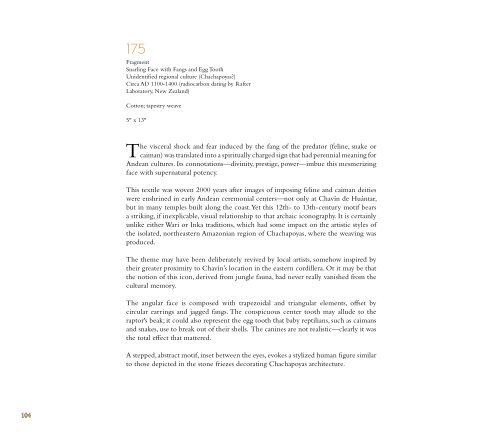You also want an ePaper? Increase the reach of your titles
YUMPU automatically turns print PDFs into web optimized ePapers that Google loves.
175<br />
Fragment<br />
Snarling Face with Fangs and Egg Tooth<br />
Unidentified regional culture (Chachapoyas?)<br />
Circa AD 1100-1400 (radiocarbon dating by Rafter<br />
Laboratory, New Zealand)<br />
Cotton; tapestry weave<br />
5" x 13"<br />
The visceral shock and fear induced by <strong>the</strong> fang of <strong>the</strong> predator (feline, snake or<br />
caiman) was translated into a spiritually charged sign that had perennial meaning for<br />
Andean cultures. Its connotations—divinity, prestige, power—imbue this mesmerizing<br />
face with supernatural potency.<br />
This textile was woven 2000 years after images of imposing feline and caiman deities<br />
were enshrined in early Andean ceremonial centers—not only at Chavín de Huántar,<br />
but in many temples built along <strong>the</strong> coast. Yet this 12th- to 13th-century motif bears<br />
a striking, if inexplicable, visual relationship to that archaic iconography. It is certainly<br />
unlike ei<strong>the</strong>r Wari or Inka traditions, which had some impact on <strong>the</strong> artistic styles of<br />
<strong>the</strong> isolated, nor<strong>the</strong>astern Amazonian region of Chachapoyas, where <strong>the</strong> weaving was<br />
produced.<br />
The <strong>the</strong>me may have been deliberately revived by local artists, somehow inspired by<br />
<strong>the</strong>ir greater proximity to Chavín’s location in <strong>the</strong> eastern cordillera. Or it may be that<br />
<strong>the</strong> notion of this icon, derived from jungle fauna, had never really vanished from <strong>the</strong><br />
cultural memory.<br />
The angular face is composed with trapezoidal and triangular elements, offset by<br />
circular earrings and jagged fangs. The conspicuous center tooth may allude to <strong>the</strong><br />
raptor's beak; it could also represent <strong>the</strong> egg tooth that baby reptilians, such as caimans<br />
and snakes, use to break out of <strong>the</strong>ir shells. The canines are not realistic—clearly it was<br />
<strong>the</strong> total effect that mattered.<br />
A stepped, abstract motif, inset between <strong>the</strong> eyes, evokes a stylized human figure similar<br />
to those depicted in <strong>the</strong> stone friezes decorating Chachapoyas architecture.<br />
104







